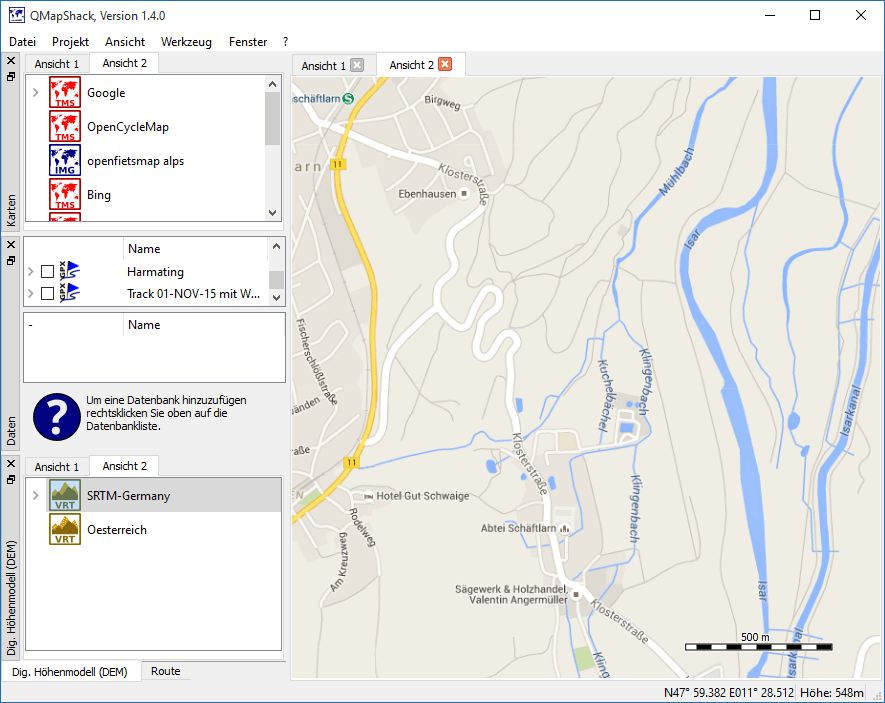
Is there a way to have Land read those values directly from the SHP file using some data columns? I'd rather style SHP files in some pre processing step in Python or C++ than clicking in the Land UI for 100s of layers :)įinally I tried the latest OSM snapshot of Switzerland. I can modify the layer's color or routing properties. It imported all features as a single layer. It seems to be able to import the vector data just fine. Can you maybe shed light why Land asks for projection?

I also have to pick a projection for some reason even though this information should be in Geotiff metadata. Geotiff can be imported, but Land is a bit picky on the actual format (deflate compression would give a corrupted image, but LZW compression would work).
#Qmapshack trial
I gave the trial version of Land a try and can mostly confirm what you told me. Idem (Personnal MTB customisation + Altitudes Curves fron French IGN - A Shp layers Add with Land) Raster map (Rmap), OSM (QGIS, OOM, LND) relief and curved (Shp layer) is provide by French IGN (5 m precision) Here under a screen shot of th GPS for TwoMap. Color, object dispalayed, track and path aspect, etc.) Here under land Screen Copy (Open Street map -> MVPF With personal MTB cusomisation. Then Land imports or opens this format to either make a *.imp or *.rmap map. Then export this georeferenced map in *.tif format. GIS data can be manipulated with QGIS (Extract/merge/cut/ect.)įrom the *.shp layers it is possible to build a map, whose appearance is fully customizable, with Open Orienteering Mapper. You can authorize/inhibit the layers displayed by adapting the aspect (shape/color) property menu it will be necessary to save your aspect modifications in a *.clay file (which by changing the name applies to all *.mpv maps or *.mpvf) warning at first it's long tedious but once done it's quick to propagate the aspect. You can save it in *.mpv or *.mpvf format (format usable by GPS) The Edit Menu allows you to modify it or make it "routable. You have to wait but a map file will be in your download folder You open Open Street Map, you center the area of the screen on your sector of interest and you click on EXPORT / API OVERPASS. Regarding the use or exploitation of this data, with land it is quite simple.
#Qmapshack update
So concerning the update of this data you can do it either directly on the Open Street Map site or with the JOSM tool In fact it's quite simple, "open" GIS data is mostly taken from Open Street Map. Is the TwoNav ecosystem more open to importing custom vector and raster data? So overall it looks like twonav spent some effort, but might be lacking the community behind garmin devices that creates tools and reverse engineers formats, but I'd like to hear other people's opinions. (Like which SHP properties map to which map properties.how to specify roads/trails/.?).
#Qmapshack pro
Land Pro seems to be able to read more common formats like SHP and TIF and create maps form it, but I could not find any specifications HOW it does that. I don't think they are open or specified anywhere. Except for KML and KMZ (which are no high performance formats) none of these formats ring a bell.
#Qmapshack manual
Looking at the cross manual I can see that IMP, KML, KMZ, MPVF, RMAP, RTMAP, VMAP are supported. There is also always the danger that one day Garmin decides to lock down their devices further rendering my work useless. This worked quite well for vector data for Garmin (thanks to the excellent mkgmap and a little bit of coding) but is frustrating for raster data.

So it became quite a hobby of myself trying to get GIS data on my GPS devices. Unfortunately, map data is almost always in some custom, country specific format. Many countries (for example Switzerland, Norway, the US) publish free map data.


 0 kommentar(er)
0 kommentar(er)
